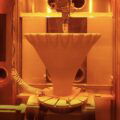Astronomers have spotted a pair of supermassive black holes that are not only huge, but are also the closest black holes to Earth. And according to the researchers who made the discovery, the two black holes are close enough to each other that given enough time they will ultimately merge into one ultra-supermassive black hole.
BACKGROUND: BLACK HOLES ARE ALREADY UNUSUAL
The Debrief recently reported on a pair of videos showing what it would be like to try to travel into a black hole. We also covered the direct imaging of a black hole’s event horizon, another astronomy first, as well as a new theory that black holes may function as gates through space and time.
Now, the folks operating the European Southern Observatory’s Very Large Telescope (ESO’s VLT) have taken a snapshot of a pair of supermassive black holes they say are the closest such pair to Earth.
ANALYSIS: TO CLOSE FOR ASTRONOMICAL COMFORT
Led by Karina T. Voggel from the Université de Strasbourg, CNRS, Observatoire astronomique de Strasbourg, in France, the team was able to measure the masses of the two black holes by observing how their immense gravitational pull affects the motion of nearby stars. The larger of the two was found to have a mass almost 154 million times that of our own sun, while it’s much smaller yet still massive partner clocked in at around 6 million times the mass of our sun.
“The two objects also have a much smaller separation than any other previously spotted pair of supermassive black holes,” the press release announcing the exciting discovery states, “and will eventually merge into one giant black hole.”
“It is the first time the masses have been measured in this way for a supermassive black hole pair,” that same release adds. “This feat was made possible thanks to the close proximity of the system to Earth and the detailed observations the team obtained at the Paranal Observatory in Chile using the Multi-Unit Spectroscopic Explorer (MUSE) on ESO’s VLT.”
These measurements, along with others from the Hubble telescope, helped the team confirm that the massive objects they were seeing were indeed black holes.
OUTLOOK: LOOK AND YE SHALL FIND
The study authors note that astronomers had long suspected that our galaxy hosted two black holes, “but they had not been able to confirm their presence until now since we do not see large amounts of high-energy radiation coming from their immediate surroundings, which would otherwise give them away.”
This discovery changes that equation, and may lead to similar discoveries.
“Our finding implies that there might be many more of these relics of galaxy mergers out there and they may contain many hidden massive black holes that still wait to be found,” said Voggel. “It could increase the total number of supermassive black holes known in the local Universe by 30 percent.”
The same study notes that the search for more of these hidden supermassive black holes will get a massive boost with the ESO’s planned Extremely Large Telescope, which is set to commence operations in Chile’s Atacama Desert later this year.
“This detection of a supermassive black hole pair is just the beginning,” says study co-author Steffen Mieske, an astronomer at ESO in Chile and Head of ESO Paranal Science Operations. “With the HARMONI instrument on the ELT we will be able to make detections like this considerably further than currently possible. ESO’s ELT will be integral to understanding these objects.”
Follow and connect with author Christopher Plain on Twitter: @plain_fiction
